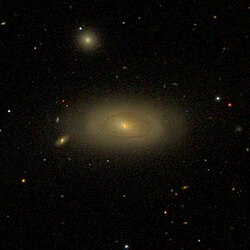astro.wikisort.org - Galaxy
NGC 4309 is a lenticular galaxy located about 55 million light-years away[3] in the constellation Virgo. The galaxy was discovered by astronomer Christian Peters in 1881[4] and is a member of the Virgo Cluster.[5][6]
| NGC 4309 | |
|---|---|
 SDSS image of NGC 4309 | |
| Observation data (J2000 epoch) | |
| Constellation | Virgo[1] |
| Right ascension | 12h 22m 12.4s[2] |
| Declination | 07° 08′ 40″[2] |
| Redshift | 0.002899[2] |
| Helio radial velocity | 869 km/s[2] |
| Distance | 54 Mly (16.6 Mpc)[2] |
| Group or cluster | Virgo Cluster |
| Apparent magnitude (V) | 13.6[2] |
| Characteristics | |
| Type | SAB0^+(r)[2] |
| Size | ~62,000 ly (19 kpc) (estimated)[2] |
| Apparent size (V) | 4.99 x 0.79[2] |
| Other designations | |
| UGC 7435, PGC 40051, VCC 0534, MCG +01-32-025[2] | |
NGC 4309 is classified as an AGN[7] and has undergone ram-pressure stripping.[8]
Globular clusters
Within a distance of 160,000 ly (50 kpc) from NGC 4309 exists a population of 162 globular clusters that surround the galaxy.[9]
See also
References
- R. W. Sinnott, ed. (1988). The Complete New General Catalogue and Index Catalogue of Nebulae and Star Clusters by J. L. E. Dreyer. Sky Publishing Corporation and Cambridge University Press. ISBN 978-0-933346-51-2.
- "NASA/IPAC Extragalactic Database". Results for NGC 4309. Retrieved 2007-03-30.
- "Your NED Search Results". ned.ipac.caltech.edu. Retrieved 2019-09-01.
- "New General Catalog Objects: NGC 4300 - 4349". cseligman.com. Retrieved 2019-08-19.
- Binggeli, B.; Sandage, A.; Tammann, G. A. (1985-09-01). "Studies of the Virgo Cluster. II - A catalog of 2096 galaxies in the Virgo Cluster area". The Astronomical Journal. 90: 1681–1759. Bibcode:1985AJ.....90.1681B. doi:10.1086/113874. ISSN 0004-6256.
- "Detailed Object Classifications". ned.ipac.caltech.edu. Retrieved 2019-09-01.
- Gavazzi, G.; Fumagalli, M.; Fossati, M.; Galardo, V.; Grossetti, F.; Boselli, A.; Giovanelli, R.; Haynes, M. P. (2013-05-01). "Halpha3: an Halpha imaging survey of HI selected galaxies from ALFALFA. II. Star formation properties of galaxies in the Virgo cluster and surroundings". Astronomy and Astrophysics. 553: A89. arXiv:1303.2846. Bibcode:2013A&A...553A..89G. doi:10.1051/0004-6361/201218789. ISSN 0004-6361.
- Köppen, J; Jáchym, P; Taylor, R; Palouš, J (2018-10-01). "Ram pressure stripping made easy: an analytical approach". Monthly Notices of the Royal Astronomical Society. 479 (4): 4367–4390. arXiv:1806.05887. Bibcode:2018MNRAS.479.4367K. doi:10.1093/mnras/sty1610. ISSN 0035-8711. S2CID 119245255.
- Zaritsky, Dennis; Aravena, Manuel; Athanassoula, E.; Bosma, Albert; Comerón, Sébastien; Elmegreen, Bruce G.; Erroz-Ferrer, Santiago; Gadotti, Dimitri A.; Hinz, Joannah L. (2015-01-27). "Globular Cluster Populations: First Results from S4G Early-Type Galaxies". The Astrophysical Journal. 799 (2): 159. arXiv:1411.4615. Bibcode:2015ApJ...799..159Z. doi:10.1088/0004-637X/799/2/159. ISSN 1538-4357.
External links
Wikimedia Commons has media related to NGC 4309.
- NGC 4309 on WikiSky: DSS2, SDSS, GALEX, IRAS, Hydrogen α, X-Ray, Astrophoto, Sky Map, Articles and images
На других языках
[de] NGC 4309
NGC 4309 ist eine linsenförmige Galaxie vom Hubble-Typ SB0-a[2] im Sternbild Jungfrau am Nordsternhimmel. Sie ist schätzungsweise 36 Millionen Lichtjahre von der Milchstraße entfernt. Die Galaxie wird unter der Katalognummer VVC 524 als Teil des Virgo-Galaxienhaufens gelistet.- [en] NGC 4309
[ru] NGC 4309
NGC 4309 (другие обозначения — UGC 7435, IRAS12196+0725, MCG 1-32-25, VCC 534, ZWG 42.51, NPM1G +07.0289, PGC 40051) — галактика в созвездии Дева.Текст в блоке "Читать" взят с сайта "Википедия" и доступен по лицензии Creative Commons Attribution-ShareAlike; в отдельных случаях могут действовать дополнительные условия.
Другой контент может иметь иную лицензию. Перед использованием материалов сайта WikiSort.org внимательно изучите правила лицензирования конкретных элементов наполнения сайта.
Другой контент может иметь иную лицензию. Перед использованием материалов сайта WikiSort.org внимательно изучите правила лицензирования конкретных элементов наполнения сайта.
2019-2025
WikiSort.org - проект по пересортировке и дополнению контента Википедии
WikiSort.org - проект по пересортировке и дополнению контента Википедии